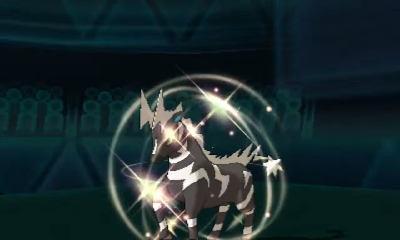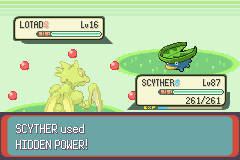Hidden Power (move)
| Hidden Power めざめるパワー Awakening Power | ||||||||||||
| ||||||||||||
Range
| ||||||||||||
Availability
| ||||||||||||
| ||||||||||||
| ||||||||||||
| ||||||||||||
| ||||||||||||
Hidden Power (Japanese: めざめるパワー Awakening Power) is a damage-dealing Normal-type move introduced in Generation II. Although it appears as a Normal-type move, Hidden Power's actual type and base power vary. For calculation on Hidden Power, see Hidden Power calculation. It has been TM10 since Generation II.
Effect
Hidden Power inflicts damage using a type and base power determined by the user's IVs.
Hidden Power can receive same-type attack bonus. For instance, a Bug-type Pokémon will receive same-type attack bonus when using a Bug-type Hidden Power. Although Hidden Power is Normal-type in the game's data, a Normal-type Hidden Power is not obtainable. Because of this, a pure Normal-type Pokémon will never receive same-type attack bonus when using Hidden Power unless it also has Normalize as its Ability.
Mystery Dungeon
The type and base power of Hidden Power is randomly calculated whenever a Pokémon enters a dungeon, and does not change between floors. The type is selected among each of the 17 types with roughly equal probability (the game chooses from the 18 types, including the ???-type, choosing again if the ???-type is chosen; if this is done 100 times consecutively, Hidden Power will be of the Fire-type). The base power of the move is chosen among the following values with equal probability: 2, 4, 6, 7, 8, 9, 10, 13, 15, and 17.
Rumble/Rumble Blast
Hidden Power is randomly assigned any of the 17 types whenever Pokémon toy has it as one of its moves. The typing does not change for as long as the Pokémon keeps the move.
Description

|
This section is incomplete. Please feel free to edit this section to add missing information and complete it. Reason: Colo and XD description |
|
Learnset
By leveling up
| # | Pokémon | Type | Level | |||||||||||
|---|---|---|---|---|---|---|---|---|---|---|---|---|---|---|
| II | III | IV | V | VI | ||||||||||
| 199 | 
|
Slowking | Water | Psychic | -- | -- | ' | |||||||
| 201 | 
|
Unown | Psychic | -- | -- | -- | -- | ' | ||||||
| 307 | 
|
Meditite | Fighting | Psychic | 18 | 17 | 15 | 15 | ' | |||||
| 308 | 
|
Medicham | Fighting | Psychic | 18 | 17 | 15 | 15 | ' | |||||
| 412 | 
|
Burmy | Bug | 20 | 20 | ' | ||||||||
| 413 | 
|
Wormadam | Bug | Grass | 20 | 20 | ' | |||||||
| 414 | 
|
Mothim | Bug | Flying | 20 | 20 | ' | |||||||
| 422 | 
|
Shellos | Water | 16 | 16 | ' | ||||||||
| 423 | 
|
Gastrodon | Water | Ground | 16 | 16 | ' | |||||||
| 577 | 
|
Solosis | Psychic | 14 | ' | |||||||||
| 578 | 
|
Duosion | Psychic | 14 | ' | |||||||||
| 579 | 
|
Reuniclus | Psychic | 14 | ' | |||||||||
| 605 | 
|
Elgyem | Psychic | 22 | ' | |||||||||
| 606 | 
|
Beheeyem | Psychic | 22 | ' | |||||||||
| Bold indicates a Pokémon gains STAB from this move. Italics indicates a Pokémon whose evolution or alternate form receives STAB from this move. A dash (−) indicates a Pokémon cannot learn the move by the designated method. An empty cell indicates a Pokémon that is unavailable in that game/generation. | ||||||||||||||
By TM
| # | Pokémon | Type | Machine | |||||||||||
|---|---|---|---|---|---|---|---|---|---|---|---|---|---|---|
| II TM10 |
III TM10 |
IV TM10 |
V TM10 |
VI TM08 | ||||||||||
| All Pokémon who can learn TMs can learn Hidden Power. | ||||||||||||||
| Bold indicates a Pokémon gains STAB from this move. Italics indicates a Pokémon whose evolution or alternate form receives STAB from this move. A dash (−) indicates a Pokémon cannot learn the move by the designated method. An empty cell indicates a Pokémon that is unavailable in that game/generation. | ||||||||||||||
"Testing" Hidden Power
Players are able to test what the type of their Hidden Power is most often by utilizing a Kecleon. It does not have to be their own, though this makes it more convenient. Entering any Double Battle with the Pokémon with Hidden Power and Kecleon at the front of the list, then using Hidden Power on the Kecleon will cause it to change types to the type that Hidden Power is, or, if the Hidden Power is a Ghost-type move, cause nothing to happen due to Kecleon's immunity.
However, in Platinum, there is a man in the Veilstone Game Corner Prize Exchange house that will tell the player the type of their Pokémon's Hidden Power, and, even if the Pokémon doesn't know Hidden Power, the type that it would have. In HeartGold and SoulSilver, he is present in the Celadon Game Corner Prize Exchange house. In Black and White, he is present in the Pokémon Center in Mistralton City. In Black 2 and White 2, he's been relocated to the Pokémon World Tournament.
In the anime
| [show] |
In the manga
In the Pokémon Adventures manga
| [show] |
In other generations
Trivia
- In Generation II, Shiny Pokémon could only use a Grass- or Dragon-type Hidden Power due to the spread of individual values required for alternate coloration.
- Prior to Generation IV, Hidden Power was one of the only two moves (along with Weather Ball) which could, depending on the Pokémon, be either physical or special, due to the damage category being determined by the type.
- More Pokémon can learn Hidden Power than any other move (except Struggle).
In other languages
| ||||||||||||||||||||||||||||||||||||||||||||||||||||||
| Generation II TMs | |
|---|---|
| 01 • 02 • 03 • 04 • 05 • 06 • 07 • 08 • 09 • 10 • 11 • 12 • 13 • 14 • 15 • 16 • 17 • 18 • 19 • 20 • 21 • 22 • 23 • 24 • 25 26 • 27 • 28 • 29 • 30 • 31 • 32 • 33 • 34 • 35 • 36 • 37 • 38 • 39 • 40 • 41 • 42 • 43 • 44 • 45 • 46 • 47 • 48 • 49 • 50 | |
| Generation II HMs | |
| 01 • 02 • 03 • 04 • 05 • 06 • 07 | |
| Generation III TMs | |
|---|---|
| 01 • 02 • 03 • 04 • 05 • 06 • 07 • 08 • 09 • 10 • 11 • 12 • 13 • 14 • 15 • 16 • 17 • 18 • 19 • 20 • 21 • 22 • 23 • 24 • 25 26 • 27 • 28 • 29 • 30 • 31 • 32 • 33 • 34 • 35 • 36 • 37 • 38 • 39 • 40 • 41 • 42 • 43 • 44 • 45 • 46 • 47 • 48 • 49 • 50 | |
| Generation III HMs | |
| 01 • 02 • 03 • 04 • 05 • 06 • 07 • 08RSE | |
| Generation IV TMs | |
|---|---|
| 01 • 02 • 03 • 04 • 05 • 06 • 07 • 08 • 09 • 10 • 11 • 12 • 13 • 14 • 15 • 16 • 17 • 18 • 19 • 20 • 21 • 22 • 23 24 • 25 • 26 • 27 • 28 • 29 • 30 • 31 • 32 • 33 • 34 • 35 • 36 • 37 • 38 • 39 • 40 • 41 • 42 • 43 • 44 • 45 • 46 47 • 48 • 49 • 50 • 51 • 52 • 53 • 54 • 55 • 56 • 57 • 58 • 59 • 60 • 61 • 62 • 63 • 64 • 65 • 66 • 67 • 68 • 69 70 • 71 • 72 • 73 • 74 • 75 • 76 • 77 • 78 • 79 • 80 • 81 • 82 • 83 • 84 • 85 • 86 • 87 • 88 • 89 • 90 • 91 • 92 | |
| Generation IV HMs | |
| 01 • 02 • 03 • 04 • 05 (DPPt • HGSS) • 06 • 07 • 08 | |
| Generation V TMs | |
|---|---|
| 01 • 02 • 03 • 04 • 05 • 06 • 07 • 08 • 09 • 10 • 11 • 12 • 13 • 14 • 15 • 16 • 17 • 18 • 19 20 • 21 • 22 • 23 • 24 • 25 • 26 • 27 • 28 • 29 • 30 • 31 • 32 • 33 • 34 • 35 • 36 • 37 • 38 39 • 40 • 41 • 42 • 43 • 44 • 45 • 46 • 47 • 48 • 49 • 50 • 51 • 52 • 53 • 54 • 55 • 56 • 57 58 • 59 • 60 • 61 • 62 • 63 • 64 • 65 • 66 • 67 • 68 • 69 • 70 • 71 • 72 • 73 • 74 • 75 • 76 77 • 78 • 79 • 80 • 81 • 82 • 83 • 84 • 85 • 86 • 87 • 88 • 89 • 90 • 91 • 92 • 93 • 94 • 95 | |
| Generation V HMs | |
| 01 • 02 • 03 • 04 • 05 • 06 | |

|
This article is part of Project Moves and Abilities, a Bulbapedia project that aims to write comprehensive articles on two related aspects of the Pokémon games. |
- Generation II TM moves
- Generation III TM moves
- Generation IV TM moves
- Generation V TM moves
- Moves
- Moves that can target any adjacent Pokémon
- Normal-type moves
- Smart moves
- Special moves
- Generation II moves
- Articles needing more information
- TM moves that all Pokémon that can learn TMs can learn
- Machine moves
- Game mechanics










































